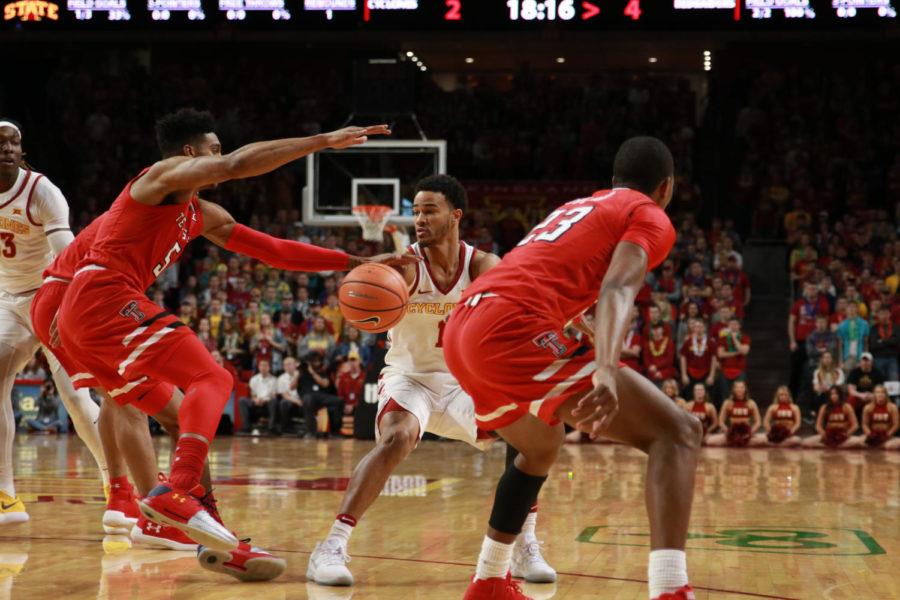Scouting report: Texas Tech’s overpowering defense
January 15, 2019
There’s a reason Iowa State’s next opponent, Texas Tech (15-1, 4-0 Big 12) is ranked eighth nationally.
The Red Raiders’ only loss came against No. 1 Duke nearly a month ago. The Blue Devils scored 69 points on Texas Tech, the most any team has scored on coach Chris Beard’s squad all season. Duke and Memphis (67 points) are the only teams to score 65 or more on Texas Tech this year.
For comparison, Iowa State’s defense is rated 26th in the nation by KenPom. The Cyclones play strong defense — yet they allow 64.6 points per game, something Texas Tech has allowed twice all season. Texas Tech’s defense is rated No. 1 by KenPom as a result.
What makes the Red Raiders’ defense so effective? There’s a lot that goes into it.
Physical, aggressive man-to-man
Texas Tech’s defense relies a lot on help. When Iowa State has the ball on one side of the floor in the half-court, you’ll notice the Red Raiders’ defenders on the opposite side shading into the paint.
On this play, Texas Tech guard Matt Mooney is sagging off his man at the bottom of the frame. There’s also help defense waiting at the top of the key in case Oklahoma was able to squeeze past the defense using the screen.
Texas Tech forces teams to pass the ball frequently. The more ball movement and player movement, the better the offense’s chance to score. If Iowa State plays slow and allows Texas Tech to set up its defense, the Cyclones will be in for a long night.
The other main challenge with Texas Tech in the half-court is the way they defend screens.
Here, you can see how Texas Tech cuts off screens, forcing the ball-handler to drive away from the screen into a potential double team. At the very least, the ball-handler will be delayed considerably and Texas Tech’s help defenders can get back into position.
For Iowa State, redshirt junior forward Michael Jacobson could be critical.
When the ball-handler rejects the screen at the top of the key and attacks the help defender, it can momentarily free up the screener. For Iowa State, that will often be Jacobson, who is Iowa State’s second leading scorer at 13.6 points per game.
In plays like this, Jacobson could get the ball at the top of the key with a brief moment of freedom as the Red Raiders scramble back to cover him. Jacobson has hit 36 percent of his 3-pointers this season, so that could be a threat. If Iowa State plans to use ball screens against Texas Tech, it will have to rely on Jacobson and the other bigs to make the right reads.
The good news for the Cyclones? When done right, the offense can work its way to a 3-on-2 situation. In the play above, the Red Raiders again invited Oklahoma to drive into the help defender. Oklahoma’s Jamal Bieniemy was able to drive deeper into the defense than normal, leaving forward Matt Freeman open at the top of the key.
From there, Texas Tech has two defenders on the right side of the court to defend three Sooners. The Red Raiders will rotate back quickly, but there’s a second or two with a major advantage.
That’s where Iowa State will have to attack. The guards — Nick Weiler-Babb, Marial Shayok, Talen Horton-Tucker, Tyrese Haliburton and Lindell Wigginton — will have to make quick decisions and hit open shots.
Size and length
Texas Tech has the athleticism and size to make life difficult for any offense.
Led by 6-foot-6 sophomore Jarrett Culver, the Red Raiders are great at closing gaps and getting into passing lanes. Texas Tech ranks fifth nationally in forcing turnovers, doing so on 24.6 percent of possessions.
Even if the Cyclones are able to limit turnovers, shots won’t come easy. Tariq Owens, a 6-foot-10 forward, is eighth in the country in block percentage. The Red Raiders as a team are sixth in Division I in blocks.
In their last game, the Red Raiders started three players at 6-foot-6 or above. Two of their three reserves who saw the floor are 6-foot-5. It’s a similar recipe to the one Iowa State has used with tall, versatile guards.
If Iowa State is going to come out of Lubbock with a win, it will likely be because Jacobson and the wings share the ball smartly and hit open shots. A win won’t come easy against the Texas Tech defense.
















